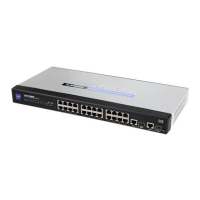Chapter 5
Advanced Configuration
35
24-Port 10/100 + 2-Port 10/100/1000 Gigabit Advanced Smart Switch with 2 Combo SFPs
VLAN ID Indicates the VLAN ID associated with the static
MAC address.
Port ID Indicates the port associated with the static MAC
address.
Admin > MAC Address Table
Switches store the addresses for all known devices in a
forwarding database. This information is used to forward
traffic directly between the inbound and outbound ports.
All the addresses learned by monitoring traffic are stored
in the dynamic address table.
Admin > MAC Address Table
L2 Table Aging
Sets the aging time for entries in the forwarding database.
The aging time is used to age out dynamically learned
forwarding information.
Enable L2 Table Aging Click the check box to enable L2
Table Aging.
Aging Time This is the amount of time after which
dynamic address table entries are discarded. Set the Aging
Time by entering the number of seconds into the text field
provided. (Default: 300 seconds)
Click Save Settings to save the changes.
MAC Address Table
Item Index of the displayed source MAC addresses.
Source MAC Displays the source MAC address mapped
to this interface.
VLAN ID Displays the VLAN ID associated with the source
MAC address
Port Displays the port associated with the source MAC
address.
Status Displays the status of the source MAC addresses.
Click Reload Address Table to retrieve the current L2
address table
Admin > Logging
The system allows you to enable or disable event logging,
and specify which even levels are logged to RAM or flash
memory. Severe error messages that are logged to flash
memory are permanently stored in the Switch to assist in
troubleshooting network problems.
Admin > Logging
Logging Target
Memory Click Memory to display log messages stored in
the Switch’s RAM memory.
Flash Click Flash to display log messages stored in the
Switch’s Flash memory.
Console Use console to display log messages.
Add Server
Allows you configure the logging of messages that are
sent to remote Syslog servers.
Name Define a name for identifying this Syslog server.
IP Address IP Address of the Syslog server.
Port UDP port of the Syslog server.
Facility The Facility value to be used when logs are
recorded in the remote server.
Click Add to add the Syslog Server.
Click the appropriate check boxes under Error, Warning,
Info, and Debug to indicate what kind of events you want
the logging target to record.
Click CLEAR to clear the log messages stored in RAM
memory and Flash memory.
Click Save Settings to save the changes.

